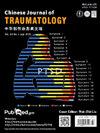挽救外周动脉损伤肢体的规程化方法:十年经验
IF 1.9
4区 医学
Q2 ORTHOPEDICS
引用次数: 0
摘要
目的:外周动脉损伤(PAI)的预后取决于多种因素,如温暖缺血时间和并发损伤。不理想的院前护理可能会导致病情延误,而缺乏专门的创伤系统可能会导致较差的预后。此外,有关这些结果的报道也很少。本研究旨在回顾我们十多年来处理 PAI 的经验,并确定这些患者肢体缺失的预测因素:本研究对一家一级创伤中心自 2008 年 1 月至 2019 年 12 月期间收治的创伤患者的前瞻性数据库进行了回顾性分析。研究对象包括急性上肢动脉损伤或腘动脉水平或以上的下肢动脉损伤患者。采用多重逻辑回归法研究了肢体缺失与缺血时间、损伤机制和伴随损伤的关系。统计分析使用 STATA 15.0 版(Stata Corp LLC,德克萨斯州)进行:在 716 名 PAI 患者中,大多数(92%)为年轻男性。钝性创伤是最常见的损伤机制。缺血时间中位数为 4 小时(四分位间范围为 2-7 小时)。肱动脉(28%)是最常见的受伤血管,其次是腘动脉(18%)和股动脉(17%)。肢体抢救率为 78%。其中,158 名(22%)患者需要截肢,53 名(7%)患者进行了初次截肢。大部分(86%)需要初次或二次截肢的患者都有钝器伤。多变量分析显示,钝器创伤、缺血时间超过6小时以及同时伴有静脉、骨骼和软组织损伤的患者截肢的几率更高:在我们的系列研究中,肢体总抢救率为78%。钝器致伤、伴有骨骼和软组织损伤、缺血时间超过 6 小时预示着预后不良。预防损伤、强有力的院前护理和快速转诊至专业的创伤中心是几项有效的措施,可降低与血管损伤相关的发病率。本文章由计算机程序翻译,如有差异,请以英文原文为准。
Protocolized approach saves the limb in peripheral arterial injury: A decade experience
Purpose
Outcomes of peripheral arterial injury (PAI) depend on various factors, such as warm ischemia time and concomitant injuries. Suboptimal prehospital care may lead to delayed presentation, and a lack of dedicated trauma system may lead to poorer outcome. Also, there are few reports of these outcomes. The study aims to review our experience of PAI management for more than a decade, and identify the predictors of limb loss in these patients.
Methods
This is a retrospective analysis of prospectively maintained database of trauma admissions at a level I trauma center from January 2008 to December 2019. Patients with acute upper limb arterial injuries or lower limb arterial injuries at or above the level of popliteal artery were included. Association of limb loss with ischemia time, mechanism of injury, and concomitant injuries was studied using multiple logistic regressions. Statistical analysis was performed using STATA version 15.0 (Stata Corp LLC, Texas).
Results
Out of 716 patients with PAI, the majority (91.9%) were young males. Blunt trauma was the most common mechanism of injury. Median ischemia time was 4 h (interquartile range 2–7 h). Brachial artery (28.5%) was the most common injured vessel followed by popliteal artery (17.5%) and femoral artery (17.3%). Limb salvage rate was 78%. Out of them, 158 (22.1%) patients needed amputation, and 53 (7.4%) had undergone primary amputation. The majority (88.6%) of patients who required primary or secondary amputations had blunt trauma. On multivariate analysis, blunt trauma, ischemia time more than 6 h and concomitant venous, skeletal, and soft tissue injuries were associated with higher odds of amputation.
Conclusion
Over all limb salvage rates was 77.9% in our series. Blunt mechanism of injury and associated skeletal and soft tissue injury, ischemia time more than 6 h portend a poor prognosis. Injury prevention, robust prehospital care, and rapid referral to specialized trauma center are few efficient measures, which can decrease the morbidity associated with vascular injury.
求助全文
通过发布文献求助,成功后即可免费获取论文全文。
去求助
来源期刊

Chinese Journal of Traumatology
ORTHOPEDICS-
CiteScore
3.80
自引率
4.80%
发文量
1707
审稿时长
28 weeks
期刊介绍:
Chinese Journal of Traumatology (CJT, ISSN 1008-1275) was launched in 1998 and is a peer-reviewed English journal authorized by Chinese Association of Trauma, Chinese Medical Association. It is multidisciplinary and designed to provide the most current and relevant information for both the clinical and basic research in the field of traumatic medicine. CJT primarily publishes expert forums, original papers, case reports and so on. Topics cover trauma system and management, surgical procedures, acute care, rehabilitation, post-traumatic complications, translational medicine, traffic medicine and other related areas. The journal especially emphasizes clinical application, technique, surgical video, guideline, recommendations for more effective surgical approaches.
 求助内容:
求助内容: 应助结果提醒方式:
应助结果提醒方式:


